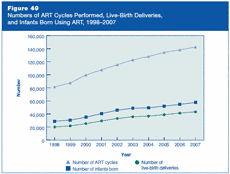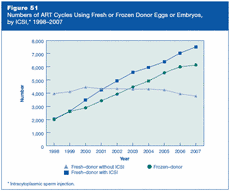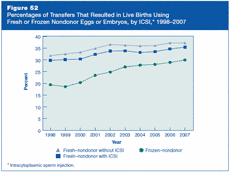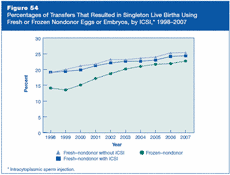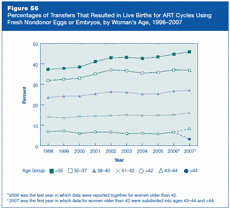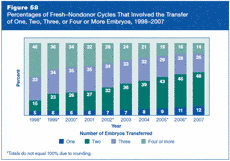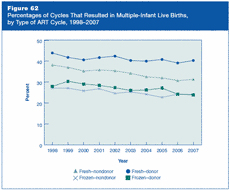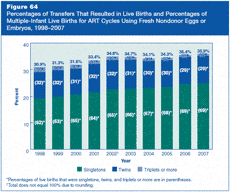2007 ART Report Section 5-ART Trends 1998-2007
This report marks the thirteenth consecutive year that CDC has published an annual report detailing the success rates for ART clinics in the United States. Having several years of data provides us with the opportunity to examine trends in ART use and success rates over time. This report features an examination of trends for the most recent 10 years, 1998–2007. Statistics for 1996 and 1997 are available in 2006 Assisted Reproductive Technology Success Rates: National Summary and Fertility Clinic Reports.
and Infants Born Using ART, 1998–2007.
Have there been changes in the types of ART cycles performed among women who used fresh or frozen nondonor eggs or embryos?
Intracytoplasmic sperm injection (ICSI) was originally developed to use in ART cycles to improve fertilization rates when severe male factor infertility was the indication for using ART. Today, this procedure is widely used even among couples without a diagnosis of male factor infertility.
Figure 50 shows the numbers of ART cycles performed using fresh nondonor eggs or embryos with or without ICSI and the numbers of cycles using frozen nondonor eggs or embryos from 1998 through 2007. During the past 10 years, while the number of fresh–nondonor cycles performed without ICSI remained stable, the number of fresh–nondonor cycles performed with ICSI increased more than 2.5 times from 24,612 in 1998 to 64,629 in 2007. The number of frozen–nondonor cycles also more than doubled, from 11,407 in 1998 to 23,133 in 2007.
Note that the information on use of ICSI is not consistently collected across clinics for ART cycles using frozen embryos; therefore, cycles using frozen nondonor eggs or embryos are presented together as one group.
Have there been changes in the types of ART cycles performed among women who used fresh or frozen donor eggs or embryos?
Figure 51 shows the numbers of ART cycles performed using fresh donor eggs or embryos with or without ICSI and the numbers of cycles using frozen donor eggs or embryos. While the number of fresh–donor cycles performed without ICSI remained fairly stable during the past 10 years, the number of fresh–donor cycles performed with ICSI increased from 2,031 in 1998 to 7,500 in 2007. The number of frozen–donor cycles increased from 1,999 in 1998 to 6,130 in 2007. In particular, during reporting year 2007, fresh donor eggs with ICSI were used the most among all donor cycles.
Note that the information on use of ICSI is not consistently collected across clinics for ART cycles using frozen embryos; therefore, cycles using frozen donor eggs or embryos are presented together as one group.
Have there been changes in percentages of transfers that resulted in live births among women who used fresh or frozen nondonor eggs or embryos?
Figure 52 presents percentages of transfers that resulted in live births for ART cycles using fresh nondonor eggs or embryos with or without ICSI and for cycles using frozen nondonor eggs or embryos. Percentages of transfers that resulted in live births are presented rather than percentages of cycles that resulted in live births because this is the only way to directly compare cycles using fresh embryos with those using frozen embryos.
Overall, higher percentages of transfers that resulted in live births were consistently observed among fresh–nondonor cycles when compared with frozen–nondonor cycles. The percentage of transfers that resulted in live births for fresh–nondonor cycles performed without ICSI increased from 32% in 1998 to 37% in 2007. Over the same period, the percentage of transfers that resulted in live births for cycles using fresh nondonor embryos with ICSI remained slightly lower than those without ICSI, but steadily increased. The percentage of transfers that resulted in live births for cycles using frozen nondonor embryos increased from 19% in 1998 to 30% in 2007, but was generally lower than the percentage of transfers that resulted in live births for cycles using fresh nondonor embryos.
Note that the information on use of ICSI is not consistently collected across clinics for ART cycles using frozen embryos; therefore, cycles using frozen nondonor eggs or embryos are presented together as one group.
Have there been changes in percentages of transfers that resulted in live births among women who used fresh or frozen donor eggs or embryos?
Figure 53 presents percentages of transfers that resulted in live births for ART cycles using fresh donor eggs or embryos with or without ICSI and for cycles using frozen donor eggs or embryos. Percentages of transfers that resulted in live births are presented rather than percentages of cycles that resulted in live births because this is the only way to directly compare cycles using fresh embryos with those using frozen embryos.
Similar to the trends shown in Figure 52 for nondonor cycles, percentages of transfers that resulted in live births for cycles using fresh donor eggs or embryos were generally higher than for cycles using frozen donor eggs or embryos during 1998–2007. The percentage of transfers that resulted in live births for cycles that used fresh donor eggs or embryos performed without ICSI increased from 42% in 1998 to 56% in 2007. Over the same period, the percentage of transfers that resulted in live births increased from 39% to 55% for cycles using fresh donor eggs or embryos with ICSI, and from 23% to 32% for cycles using frozen donor eggs or embryos.
Note that the information on use of ICSI is not consistently collected across clinics for ART cycles using frozen embryos; therefore, cycles using frozen donor eggs or embryos are presented together as one group.
Have there been changes in percentages of transfers that resulted in singleton live births among women who used fresh or frozen nondonor eggs or embryos?
Singleton live births are an important measure of success because they entail a much lower risk than multiple-infant births for adverse infant health outcomes, including prematurity, low birth weight, disability, and death. Figure 54 presents percentages of transfers that resulted in singleton live births for ART cycles using fresh nondonor eggs or embryos with or without ICSI and for cycles using frozen nondonor eggs or embryos.
While the total numbers of nondonor cycles using ICSI greatly increased over the past 10 years (see Figure 50), the percentage of transfers that resulted in singleton live births from these cycles were not any higher than those without ICSI: 19%–24% with ICSI versus 19%–25% without ICSI.
Over the same period, the percentage of transfers that resulted in singleton live births among frozen–nondonor cycles increased from 14% to 23%.
Note that the information on use of ICSI is not consistently collected across clinics for ART cycles using frozen embryos; therefore, cycles using frozen nondonor eggs or embryos are presented together as one group.
Have there been changes in percentages of transfers that resulted in singleton live births among women who used fresh or frozen donor eggs or embryos?
Singleton live births are an important measure of success because they entail a much lower risk than multiple-infant births for adverse infant health outcomes, including prematurity, low birth weight, disability, and death. Figure 55 presents percentages of transfers that resulted in singleton live births for ART cycles using fresh donor eggs or embryos with or without ICSI and for cycles using frozen donor eggs or embryos.
The percentage of transfers that resulted in singleton live births were consistently higher for fresh–donor cycles than for frozen–donor cycles. Percentages increased for fresh–donor cycles without ICSI from 23% in 1998 to 33% in 2007; the same increase was observed for cycles with ICSI. Over the same period, the percentage of transfers that resulted in singleton live births increased from 17% to 24% for frozen–donor cycles.
Note that the information on use of ICSI is not consistently collected across clinics for ART cycles using frozen embryos; therefore, cycles using frozen donor eggs or embryos are presented together as one group.
Fresh or Frozen Donor Eggs or Embryos, by ICSI, 1998–2007.
Have there been changes in percentages of transfers that resulted in live births for all ART patients or only for those in particular age groups?
Figure 56 presents percentages of transfers that resulted in live births, by woman’s age, for ART cycles using fresh nondonor eggs or embryos.
From 1998 through 2007, the percentage of transfers that resulted in live births for women younger than 35 increased 23%, from 37% in 1998 to 46% in 2007. Over the same period, the percentage of transfers that resulted in live births increased 16% (from 32% to 37%) for women 35–37, 15% (from 24% to 27%) for women 38–40, and 13% (from 14% to 16%) for women 41–42. Please note the percentage of transfers that resulted in live births were rounded to the nearest whole number while the percent changes were calculated using raw data.
Have there been changes in percentages of transfers that resulted in singleton live births for all ART patients or only for those in particular age groups?
Singleton live births are an important measure of success because they have a much lower risk than multiple-infant births for adverse infant health outcomes, including prematurity, low birth weight, disability, and death. Figure 57 presents percentages of transfers that resulted in singleton live births, by woman’s age, for ART cycles using fresh nondonor eggs or embryos.
From 1998 through 2007, the percentage of transfers that resulted in singleton live births for women younger than 35 increased 39%, from 22% in 1998 to 30% in 2007. Over the same period, the percentage of transfers that resulted in singleton live births increased 28% (from 20% to 26%) for women 35–37, 22% (from 17% to 21%) for women 38–40, and 19% (from 11% to 14%) for women 41–42. Please note the percentage of transfers that resulted in singleton live births were rounded to the nearest whole number while the percent changes were calculated using raw data.
Figure 58 presents the trends for the number of embryos transferred in fresh–nondonor cycles that progressed to the embryo transfer stage. From 1998 through 2007, cycles that involved the transfer of one embryo more than doubled, from 5% to 12%; cycles that involved the transfer of two embryos increased dramatically, from 15% in 1998 to 48% in 2007. Cycles that involved the transfer of three embryos decreased from 33% in 1998 to 26% in 2007, and cycles that involved the transfer of four or more embryos decreased dramatically from 46% in 1998 to 14% in 2007.
Has the number of embryos transferred changed in fresh–nondonor cycles for women younger than 35 who have more embryos available than they choose to transfer?
As shown in Figure 58, the number of embryos transferred in fresh–nondonor cycles has decreased during the past 10 years. Figure 59 shows the change over time in the number of embryos transferred for ART procedures in which the woman was younger than 35 and the couple chose to set aside some embryos for future cycles rather than transfer all available embryos at one time. Previous research suggests that the number of embryos available for an ART cycle is important in predicting success. Younger women also tend to have higher percentages of ART cycles that result in pregnancies and live births (see Figure 14).
Overall, the number of embryos transferred decreased among couples who chose to transfer fewer embryos than were available. In 1998, about one-third (33%) of ART cycles involved the transfer of four or more embryos; 50%, three embryos; 16%, two embryos; and less than 1%, one embryo. By the next year, 1999, the percentage of cycles in which four or more embryos were transferred had decreased to 19%; 45% of cycles, three embryos; 35% of cycles, two embryos; and 1%, one embryo. By 2007, four or more embryos were transferred in only 2% of cycles, three in 13% of cycles, two in 76% of cycles, and one in 9% of cycles.
Have there been changes in percentages of transfers that resulted in live births, by number of embryos transferred?
Figure 60 presents percentages of transfers that resulted in live births, by the number of embryos transferred for ART cycles using fresh nondonor eggs or embryos from 1998 through 2007. The percentage of transfers resulting in live births increased the most for ART cycles that involved the transfer of one or two embryos (8% to 21% and 26% to 43%, respectively). However, there were no increases for ART cycles that involved the transfer of three or four or more embryos (32% to 28% and 36% to 35%, respectively).
The relationship between number of embryos transferred and success rates is complicated by several factors, such as the woman’s age and embryo quality. Trends over time may reflect changes in these factors.
Have there been changes in percentages of transfers that resulted in live births for women younger than 35 who have more embryos available than they choose to transfer?
Figure 61 shows changes over time in the number of embryos transferred and the percentage of transfers that resulted in live births for ART cycles in which the woman was younger than 35 and chose to set aside some embryos for future cycles rather than transfer all available embryos at one time. Previous research suggests that the number of embryos available for an ART cycle is an important predictor of success. Younger women also tend to have higher percentages of ART cycles that result in pregnancies and live births (see Figure 14).
For this group of women, the percentage of transfers that resulted in live births increased over time, when one, two, or three embryos were transferred. The biggest increase was for cycles in which two embryos were transferred, from 46% in 1998 to 56% in 2007.
Percentages of transfers that resulted in live births for cycles involving the transfer of one embryo were comparable to those that involved two or three embryos. Elective single-embryo transfer minimizes the risk for multiple-fetus pregnancy and related adverse outcomes. Recently, the Society for Assisted Reproductive Technology (SART) revised its embryo transfer guidelines to encourage single-embryo transfer among patients with good prognoses. (For more information, contact SART by telephone at 205-978-5000 or online at www.sart.org.)
Multiple-infant births are associated with greater problems for both mothers and infants, including higher rates of caesarean section, prematurity, low birth weight, and infant disability or death. Figure 62 shows percentages of multiple-infant live births for the four primary types of ART procedures.
For fresh–nondonor cycles, the percentage of multiple-infant live births decreased 18% since 1998, from 38% of all live births in 1998 to 31% in 2007. Over the same period, the percentage of multiple-infant live births decreased 11% for frozen–nondonor cycles, 14% for frozen–donor cycles, and 8% for fresh–donor cycles.
Have percentages of multiple-infant live births for ART cycles using fresh nondonor eggs or embryos changed in particular age groups?
Figure 63 shows that percentages of multiple-infant live births decreased between 1998 and 2007 for women in age groups younger than 35 through women 41–42. In 1998, 42% of live-birth deliveries to women younger than 35 were multiple-infant births, compared with 35% in 2007. Among women 41–42, the percentage of multiple-infant live births decreased from 20% in 1998 to 15% in 2007.
Fresh Nondonor Eggs or Embryos, by ART Patient’s Age, 1998–2007.
Have percentages of singletons, twins, and triplets or more changed for ART cycles using fresh nondonor eggs or embryos?
Figure 64 presents the trends in percentages of transfers that resulted in live births and percentages of multiple-infant live births for ART cycles using fresh nondonor eggs or embryos. Overall, the percentage of transfers that resulted in live births increased from 31% in 1998 to 36% in 2007. From 1998 through 2007, the percentage of singleton live births increased from 62% to 69%; the percentage of twin births remained stable, ranging from 29% to 32%; and the percentage of triplet-or-more births decreased from 6% in 1998 to 2% in 2007.
It is important to note that twins, albeit to a lesser extent than triplets or more, are still at substantially greater risk for illness and death than singletons. These risks include low birth weight, preterm birth, and neurological impairments such as cerebral palsy. Both percentages of twin and triplet-or-more births remain significantly higher for ART births than for births resulting from natural conception.
Contact Us:
- Centers for Disease Control and Prevention
1600 Clifton Rd
Atlanta, GA 30333 - 800-CDC-INFO
(800-232-4636)
TTY: (888) 232-6348 - New Hours of Operation
8am-8pm ET/Monday-Friday
Closed Holidays - cdcinfo@cdc.gov
